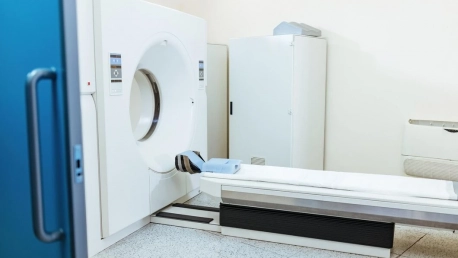Magnetic Resonance Imaging (MRI) serves as a non-invasive diagnostic tool that plays a critical role in modern medicine. It utilizes a strong magnetic field and radiofrequency waves to generate detailed images of the internal structures of the body. MRI technology is invaluable across a range of medical fields, from detecting tumors to diagnosing sports injuries. However, it is not without challenges. One of the key difficulties in MRI imaging is the need for frequent and precise calibration due to the fluctuations in the strong magnetic fields. These calibration processes are both time-consuming and costly, representing a hurdle in streamlining MRI diagnostics.
The Breakthrough of Hans Stærkind
Understanding the Innovative Sensor
Hans Stærkind’s invention harnesses the power of laser technology and the unique properties of cesium gas to precisely measure the strength of magnetic fields in MRI scanners. His innovative sensor represents a quantum leap for MRI calibration. It is designed to work seamlessly with existing technology, introducing the concept of laser light which is transmitted through fiber optic cables into a vessel containing cesium gas. As the magnetic field strength varies, so too does the frequency at which the gas absorbs the laser light. This change in absorption frequency can be measured with high precision, providing real-time data about the magnetic field strength, which can be used to correct for fluctuations that would otherwise compromise scan accuracy.
Transforming MRI Calibration and Stability
This innovative sensor system promises to reduce the need for frequent calibration and address the troublesome issue of magnetic field fluctuations that can degrade MRI image quality. The enhanced speed and accuracy of calibration that Stærkind’s sensor provides can lead to a significant increase in the throughput of MRI procedures. By minimizing the disruptions caused by magnetic instability, the sensor can achieve more consistent and reliable imaging results, potentially shortening scan times and improving the overall efficiency of MRI diagnostics. The applicability ranges from high-end research scanners to clinical machines, improving the quality and reducing the cost of MRI scans across the board.
The Advancements in MRI Technology
From Prototype to Testing
The prototype of this disruptive technology, resembling a stereo system from the 1990s, has undergone successful testing, demonstrating that it can work effectively as intended. The sensor’s integration into existing MRI systems points to a future where MRI scan costs could be reduced. By promoting faster calibration, the technology can help make MRI procedures not only more affordable but also quicker, which could lead to broader accessibility. Because the sensor can operate automatically and quickly, it’s poised to address one of MRI’s most significant limitations, making it a game-changer in the field of medical imaging.
The Future of Affordable MRI Imaging
Looking to the future, the potential for more affordable MRI scanners is considerable. Stærkind’s technology, with its ability to compensate for some level of error, suggests that high-quality images could be maintained even in circumstances that would previously have led to image degradation. This innovation could democratize access to high-quality MRI diagnostics, making them more accessible to a broader range of healthcare facilities, including those in low-resource environments.
Collaboration and Vision
The Legacy of Esben Petersen and Teamwork
This groundbreaking sensor is not just the brainchild of Hans Stærkind but also a tribute to the pioneering vision of his late supervisor, Esben Petersen. Realizing such a complex idea required an interdisciplinary approach, which saw Hans collaborating with esteemed quantum physicists at the Niels Bohr Institute. Professor Eugene Polzik and his team were instrumental in turning a sophisticated theory into a tangible reality. This collaborative effort underscores how combining expertise from various scientific fields can lead to remarkable technological breakthroughs.
Preparing for a Wider Application
As the prototype undergoes further refinement, detailed measurements are collected to ensure its precision and effectiveness. The data gathered during this phase will be instrumental in determining how the sensor can enhance various types of MRI scans. The goal is to first introduce this innovative tool into MRI research units, subsequently catching the attention of major MRI manufacturers. This recognition could set the stage for a wider adoption of Stærkind’s sensor in standard MRI equipment, which could transform diagnostic imaging on a global scale.
Implications for Healthcare
Enhancing MRI Diagnostics
The introduction of this new sensor technology is set to drastically enhance MRI diagnostics, offering a solution to one of the technology’s longest-standing problems. Its integration into new MRI machines holds the potential for not just incremental improvements but a revolution in patient diagnostics and outcomes. As MRI scanners become more robust and less prone to errors, the confidence in diagnostics should increase, leading to better healthcare delivery and patient care.
The Impact of Innovation in Medicine
Magnetic Resonance Imaging (MRI) is an essential, non-invasive medical imaging technique that leverages a powerful magnetic field alongside radio waves to render intricate images of the body’s internal structures. This technology is a cornerstone in numerous medical specialties, effectively aiding in the detection of malignancies and the assessment of various injuries.Despite its clinical importance, MRI encounters operational challenges. One significant challenge is the demand for regular calibration. The device’s magnetic fields can vary, necessitating adjustments to maintain accuracy. This calibration is not just intricate; it’s also a resource-intensive process that can interrupt regular clinical workflows, adding costs and potential delays to patient care.As MRI continues to evolve, efforts are directed toward making these systems more stable and user-friendly, minimizing the need for such frequent calibration. These innovations aim to enhance the efficiency of MRI procedures, thereby improving the overall effectiveness of medical diagnostics. In doing so, the hope is to ensure this critical imaging modality remains an accessible and reliable tool in the ever-advancing field of medicine.









